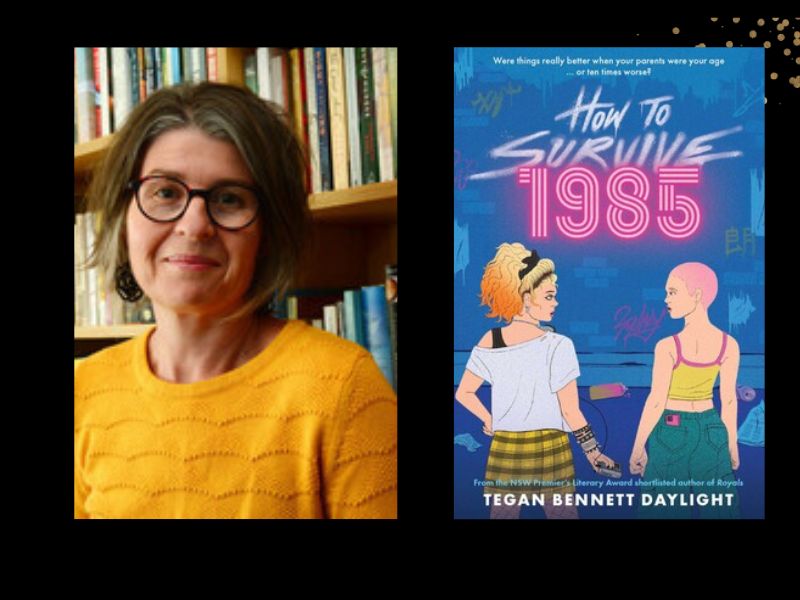Tegan Bennett Daylight is a respected, multifaceted Australian author whose literary short stories and non-fiction have been shortlisted for the Stella Prize and Prime Minister’s Literary Award.
Her first YA novel, Royals, was published in 2023 and was shortlisted for a NSW Premier’s Literary Award. Narrated by Shannon (a fully developed character), the novel revolves around a group of six teens with diverse backgrounds and disabilities and a baby they name Juno, who are trapped for weeks in a shopping centre. It is strangely empty of other people, but the pedestrians they glimpse outside are oblivious to their calls for help. Confined to this claustrophobic limbo, the new friends spend their time splurging on the free products and food but, after over-indulging, they resolve to cut back their consumption in the future.
The hotly anticipated sequel to Royals is How to Survive 1985, in which four of the teens (who have kept in contact in the ‘real world’) fall through time-slips to Sydney’s inner-west in 1985. In a loose iteration of Freaky Friday, Shannon meets her own mother, Julia, who is around her age and on the cusp of experimenting with drinking and share-house parties. Fortunately, Julia is quick to believe that Shannon is her future daughter, and their bond is explored with fun and affection.
Shannon finds Akira and Grace, some friends from the shopping plaza, through their graffiti tags. Together with James, her hyperactive romantic interest, they search for baby Juno.
Both novels place the teens in situations without internet or phone communication, perhaps eerily prescient of the upcoming Australian social media ban for under-16s. This leads to fascinating scenarios where the author plays with world-building and creates scenarios with internally consistent rules: characters can’t search the internet or contact each other through their phones and, as in Narnia and the Faraway Tree tales, no time passes in the ‘real world’ while they are away.
The novel is peppered with Generation Z pop culture and expressions such as ‘bougie’ (from ‘bourgeois’) with its contemporary positive connotation, and worldviews of tolerance and climate awareness. Most of the young protagonists personify diverse groups: First Nations, Blak, gay or trans and those living with ADHD or a physical disability. Their experiences in both the 2020s and 1985 are often seen through the lens of their ‘identity label’. Kamiloroi girl, Grace, among others, is viewed with suspicion in 1985, but is generally accepted and affirmed in the present.
Both eras have their pros and cons. Shannon sees the 80s as wilder and less regimented. She is horrified by the dog poo left on the streets and is relieved that most people are now inculcated to clean it up. She is surprised by the number of white people in the 80s compared with the diversity of Australia in the 21st century and is shocked by the ubiquity of smoking, even in confined spaces like buses, particularly knowing that her beloved grandmother has died from cancer. She is grateful that people are much more environmentally aware and proactive in the present.
Read: Book review: Half Truth, Nadia Mahjouri
How to Survive 1985 is a captivating social and cultural history that compares and contrasts the 1980s with the 2020s. It doesn’t whitewash today’s problems, but shows that many issues, particularly attitudes towards discrimination and the environment, have improved. Although set in the near past, it is a story of our time. It recognises and calls for attentiveness and active change and signals a hopeful future handover to invested young caretakers.
How to Survive 1985, Tegan Bennett Daylight
Publisher: Simon & Schuster Australia
ISBN: 9781761429712
Pages: 288pp
RRP: $22.99
Publication date: 30 April 2025

